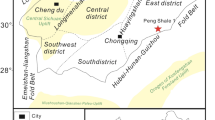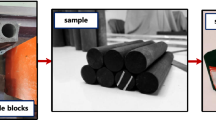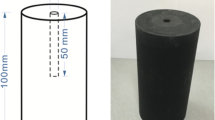Abstract
The effects of CO2 and CO2-based fluids imbibition on the mechanical properties of shale are of great importance in Sc-CO2 enhanced shale gas production and geological sequestration of CO2 in shale gas reservoirs. To investigate the influence of sub-CO2, Sc-CO2, sub-CO2–water, Sc-CO2–water, sub-CO2–Nacl, and Sc-CO2–Nacl imbibitions on shale strength, a series of triaxial compression tests is performed. A statistical damage constitutive model of shale after CO2, CO2–water, and CO2–NaCl saturation is applied to present the stress–strain relationships of shale under different immersion conditions. The results show that, after CO2, CO2–water, and CO2–NaCl imbibitions, the axial stress, Young's modulus, and axial strain are changed due to the physical and chemical reactions between shale and soaking fluids. The mechanical properties of shale display the largest variations after sub-CO2–water and Sc-CO2–water imbibitions. The variations in mechanical properties of shale resulted from precipitation of NaCl crystals under the sub-CO2–NaCl and Sc-CO2–NaCl immersion conditions are smaller than those of shale under the sub-CO2–water and Sc-CO2–water immersion conditions. Pure CO2 saturation has the smallest effect on shale’s mechanical properties among the three kinds of fluids. For the same kind of fluids, CO2 at a supercritical state shows larger effect on shale than the subcritical state. In addition, shale samples after immersion show a mixed tensile-shear failure mode. The cohesion force of shale is increased after sub-CO2 and Sc-CO2 saturation, whereas it is decreased after CO2–water and CO2–NaCl saturation. A reduction of the internal friction angles is observed for all of the soaked shale samples. Because of the anisotropy of shale samples, the actual failure angle is larger than the failure angle calculated by the Mohr–Coulomb criterion. The statistical damage constitutive equations of shale under different soaking conditions can well describe the stress–strain relationship of shale under different confining pressures. The variations of two parameters (F0 and m) in the statistical damage constitutive model well reflect the brittleness and strength of shale samples with different soaking conditions.
Highlights
-
Influences of CO2 and CO2-based fluids imbibition on mechanical properties of shales were evaluated through triaxial compression tests.
-
The stress–strain relationships of shale under different immersion conditions were analyzed.
-
A statistical damage constitutive model of shale after CO2, CO2-water, and CO2-NaCl saturation was established.









Similar content being viewed by others
References
Bai B, Ni H, Shi X, Guo X, Ding L (2021) The experimental investigation of effect of supercritical CO2 immersion on mechanical properties and pore structure of shale. Energy 228:120663
Blair SC, Cook WNG (1992) Statistical model of rock fracture, rock mechanics. Int J Rock Mech Min Sci Geomech Abstr 30(4):A218
Cao W, Li X (2008) A new discussion on damage softening statistical constitutive model for rocks and method for determining its parameters. Rock Soil Mech 29(11):2952–2956
Cao W, Zhang S (2005) Study on the statistical analysis of rock damage based on Mohr–Coulomb criterion. J Hunan Univ (nat Sci) 32(1):43–47
Cao W, Zhao M, Liu C (2004a) A study on damage statistical strength theory for rock. Chin J Geotech Eng 06:820–823
Cao W, Zhao M, Liu C (2004b) Study on the model and its modifying method for rock softening and damage based on Weibull random distribution. Chin J Mech Eng 19:3226–3231
Cao W, Zhao H, Zhang L, Zhang Y (2008) Damage statistical softening constitutive model for rock considering effect of damage threshold and its parameters determination method. Chin J Mech Eng 27(06):1148–1154
Cao W, Zhao H, Zhang Y, Zhang L (2011) Strain softening and hardening damage constitutive model for rock considering effect of volume change and its parameters determination method. Rock Soil Mech 32(03):647–654
Cao W, Zhang C, He M, Liu T (2016) Statistical damage simulation method of strain softening deformation process for rocks considering characteristics of void compaction stage. Chin J Geotech Eng 38(10):1754–1761
Cao W, Lin X, Zhang C, Yang S (2017) A statistical damage simulation method of dynamic deformation process for rocks based on nonlinear dynamic strength criterion. Chin J Rock Mech Eng 36(04):794–802
Cuéllar-Franca RM, Azapagic A (2015) Carbon capture, storage and utilisation technologies: a critical analysis and comparison of their life cycle environmental impacts. J CO2 Util 9:82–102
Dragon A, Mróz Z (1979) A continuum model for plastic-brittle behaviour of rock and concrete. Int J Eng Sci 17(2):121–137
Fang Y, Wang C, Elsworth D, Ishibashi T (2017) Seismicity-permeability coupling in the behavior of gas shales, CO2 storage and deep geothermal energy. Geomech Geophys Geo-Energ Geo-Resour 3(2):189–198
Farquhar SM, Pearce JK, Dawson GKW (2015) A fresh approach to investigating CO2 storage: experimental CO2–water–rock interactions in a low-salinity reservoir system. Chem Geol 399:98–122
Fatah A, Bennour Z, Ben Mahmud H, Gholami R, Hossain MM (2020) A Review on the influence of CO2/shale interaction on shale properties: implications of CCS in shales. Energies 13(12):3200
Feng G, Kang Y, Sun Z, Wang X, Hu Y (2019) Effects of supercritical CO2 adsorption on the mechanical characteristics and failure mechanisms of shale. Energy 173:870–882
Frantziskonis G (1995) Heterogeneity and implicated surface effects: statistical, fractal formulation and relevant analytical solution. Acta Mech 108(1–4):157–178
Frantziskonis G, Desai CS, Tuscon A (1987) Elastoplastic model with damage for strain softening geomaterials. Acta Mech 68(3–4):151–170
Gaus I (2010) Role and impact of CO2–rock interactions during CO2 storage in sedimentary rocks. Int J Greenh Gas Control 4(1):73–89
Guo X, Ni H, Li M, Zhang L, Wang Y, Ding L (2018) Experimental study on the influence of supercritical carbon dioxide soaking pressure on the mechanical properties of shale. Indian Geotech J 48(2):384–391
Gupta D, Leshchyshyn T (2005) CO2 energized hydrocarbon fracturing fluid: history and field application in tight gas wells in the rock creek gas formation. SPE 95061, presented at the SPE Latin American and SPE Latin American and Caribbean Petroleum Engineering Conference, Rio de Janeiro, Brazil, June 20–23
Hayhurst DR (1972) Creep rupture under multi-axial states of stress. J Mech Phys Solids 20(6):381–382
Heller R, Zoback M (2014) Adsorption of methane and carbon dioxide on gas shale and pure mineral samples. J Unconv Oil Gas Resour 8:14–24
Kachanov LM (1967) The theory of creep. National Lending Library for Science and Technology
Kerr RA (2010) Energy. Natural gas from shale bursts onto the scene. Science (new York) 328(5986):1624–1626
Krajcinovic D, Manuel Americo G, Silva (1982) Statistical aspects of the continuous damage theory. Int J Solids Struct 7(18):551–562
Lemaitre J (1985) A continuous damage mechanics model for ductile fracture. J Eng Mater Technol 107(1):83–89
Likhtman VI, Shchukin ED, Rebinder PA (1964) Physicochemical mechanics of metals: adsorption phenomena in the process of deformation and failure of metals. Akad. Nauk SSSR, Moscow
Lu J, Nicot J, Mickler PJ, Ribeiro LH, Darvari R (2016) Alteration of Bakken reservoir rock during CO2-based fracturing—an autoclave reaction experiment. J Unconv Oil Gas Resour 14:72–85
Lu Y, Chen X, Tang J et al (2019) Relationship between pore structure and mechanical properties of shale on supercritical carbon dioxide saturation. Energy 172:270–285
Luo X, Wang S, Wang Z et al (2015) Adsorption of methane, carbon dioxide and their binary mixtures on Jurassic shale from the Qaidam Basin in China. Int J Coal Geol 150–151:210–223
Lyu Q, Ranjith P, Long X, Ji B (2016a) Experimental investigation of mechanical properties of black shales after CO2–water–rock interaction. Materials 9(8):663
Lyu Q, Long X, Ranjith P, Kang Y (2016b) Unconventional gas: experimental study of the influence of subcritical carbon dioxide on the mechanical properties of black shale. Energies 9(7):516
Lyu Q, Long X, Ranjith PG, Tan J, Kang Y, Wang Z (2018a) Experimental investigation on the mechanical properties of a low-clay shale with different adsorption times in sub-/super-critical CO2. Energy 147:1288–1298
Lyu Q, Long X, Pg R et al (2018b) A laboratory study of geomechanical characteristics of black shales after sub-critical/super-critical CO2 + brine saturation. Geomech Geophys Geo-Energy Geo-Resour 4(2):141–156
Lyu Q, Tan J, Dick JM et al (2019) Stress-Strain modeling and brittleness variations of low-clay shales with CO2/CO2–water imbibition. Rock Mech Rock Eng 52(7):2039–2052
Lyu Q, Tan J, Li L et al (2021) The role of supercritical carbon dioxide for recovery of shale gas and sequestration in gas shale reservoirs. Energy Environ Sci 14:4203–4227
Mazars J, Pijaudier-Cabot G (1989) Continuum damage theory-application to concrete. J Eng Mech 115(2):345–365
Meng Z, Peng S, Ling B (2000) Characters of the deformation and strength under different confining pressures on sedimentary rock. J China Coal Soc 01:17–20
Meng S, ** X, Tao J, Wang X, Zhang C (2021) Evolution characteristics of mechanical properties under supercritical carbon dioxide treatment in shale reservoirs. ACS Omega 6(4):2813–2823
Murakami S, Ohno N (1980) A continuum theory of creep and creep damage. In: Ponter A.R.S., Hayhurst D.R. (eds) Creep in Structures. International Union of Theoretical and Applied Mechanics. Springer, Berlin, Heidelberg
Pompe W, Herrmann HJ, Roux S (1990) Statistical models for the fracture of disordered media. Cryst Res Technol 26(8):1076
Rafiei Renani H, Martin CD (2018) Cohesion degradation and friction mobilization in brittle failure of rocks. Int J Rock Mech Min Sci 106:1–13
Rexer TF, Mathia EJ, Aplin AC, Thomas KM (2014) High-pressure methane adsorption and characterization of pores in posidonia shales and isolated kerogens. Energy Fuels 28(5):2886–2901
Rezaee R, Saeedi A, Iglauer S, Evans B (2017) Shale alteration after exposure to supercritical CO2. Int J Greenh Gas Control 62:91–99
Tan J, Hu C, Lyu Q et al (2019) Multi-fractal analysis for the AE energy dissipation of CO2 and CO2+ brine/water treated low-clay shales under uniaxial compressive tests. Fuel 246:330–339
Tang C (1993) Catastrophe in the process of rock rupture. Coal Industry Press, Bei**g
Toews KL, Shroll RM, Wai CM, Smart NG (1995) Ph-defining equilibrium between water and supercritical CO2. Influence on SFE of organics and metal chelates. Anal Chem (washington) 67(22):4040–4043
Walton G (2019) Initial guidelines for the selection of input parameters for cohesion-weakening-friction-strengthening (CWFS) analysis of excavations in brittle rock. Tunn Undergr Space Technol 84:189–200
Wen T, Tang H, Liu Y, Zhou Z (2016) Newly modified damage statistical constitutive model of rock based on impact factor. J China Univ Min Technol 45(01):141–149
Wen T, Liu Y, Yang C, Yi X (2018) A rock damage constitutive model and damage energy dissipation rate analysis for characterising the crack closure effect. Geomech Geoeng Int J 13(1):54–63
Wen T, Tang H, Ma J, Zhang J (2019) Deformation simulation for rock in consideration of initial damage and residual strength. Earth Sci 44(02):652–663
Yang Z (2016) Study on physical and mechanical anisotropy of shale and failure characteristics in tension-shear state. Bei**g Jiaotong University, Bei**g
Yang M, Zhao M, Cao W (2005) Method for determining the parameters of statistical damage softening constitutive model for rock. J Hydraul Eng 36(3):345–349
Yang S, Yin P, Ranjith PG (2020) Experimental study on mechanical behavior and brittleness characteristics of Longmaxi Formation shale in Changning, Sichuan Basin, China. Rock Mech Rock Eng 53(5):2461–2483
Yin H, Zhou J, **an X et al (2017) Experimental study of the effects of sub- and super-critical CO2 saturation on the mechanical characteristics of organic-rich shales. Energy 132:84–95
You M (2003) Effect of confining pressure on the Young’s modulus of rock specimen. Chin J Mech Eng 01:53–60
Zhang N, Sheng Z, Li X, Li S, Hao J (2011) Study of relationship between Poisson’s ratio and angle of internal friction for rocks. Chin J Rock Mech Eng 30(S1):2599–2609
Zhou J, Liu M, **an X, Jiang Y, Liu Q, Wang X (2019) Measurements and modelling of CH4 and CO2 adsorption behaviors on shales: implication for CO2 enhanced shale gas recovery. Fuel 251:293–306
Acknowledgements
The authors are grateful for financial supports from the National Natural Science Foundation of China (Grant no. 42002160, 41872151), the Natural Science Foundation of Hunan Province, China (Grant no. 2020JJ5705), the China Hunan Provincial Science and Technology Department (2017XK2029) and the financial support by Open Fund (PLC 20190802) of State Key Laboratory of Oil and Gas Reservoir Geology and Exploitation (Chengdu University of Technology).
Author information
Authors and Affiliations
Corresponding author
Ethics declarations
Conflict of interest
On behalf of all authors, the corresponding author states that there is no conflict of interest.
Additional information
Publisher's Note
Springer Nature remains neutral with regard to jurisdictional claims in published maps and institutional affiliations.
Supplementary Information
Below is the link to the electronic supplementary material.
Rights and permissions
About this article
Cite this article
Tan, J., **e, B., Lyu, Q. et al. Mechanical Properties of Shale After CO2 and CO2-Based Fluids Imbibition: Experimental and Modeling Study. Rock Mech Rock Eng 55, 1197–1212 (2022). https://doi.org/10.1007/s00603-021-02702-w
Received:
Accepted:
Published:
Issue Date:
DOI: https://doi.org/10.1007/s00603-021-02702-w




